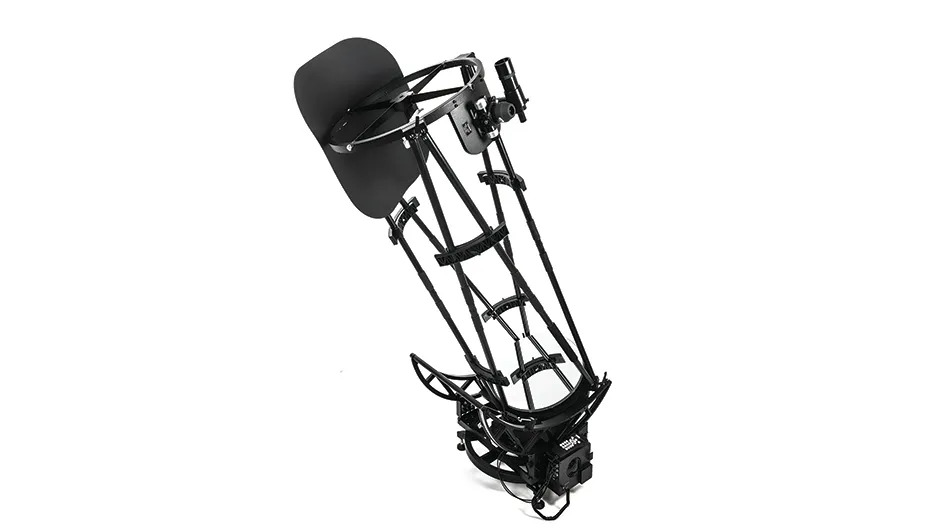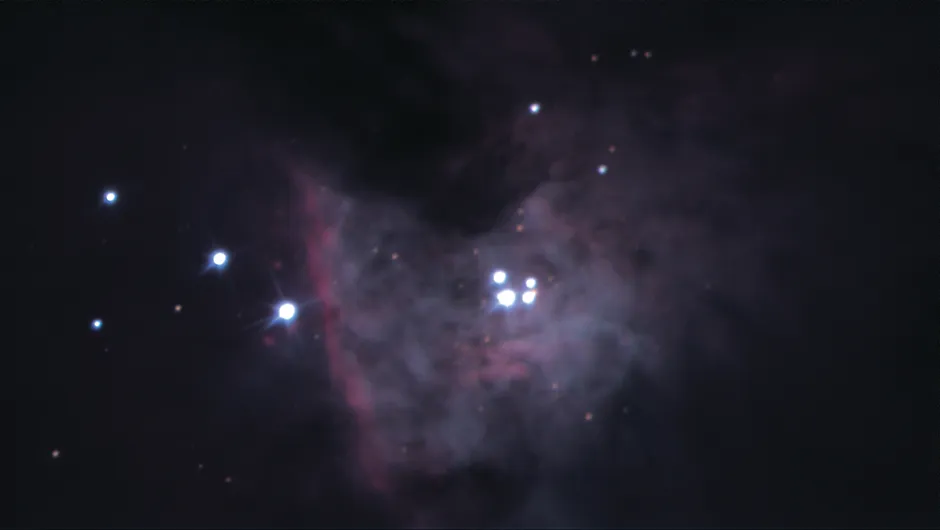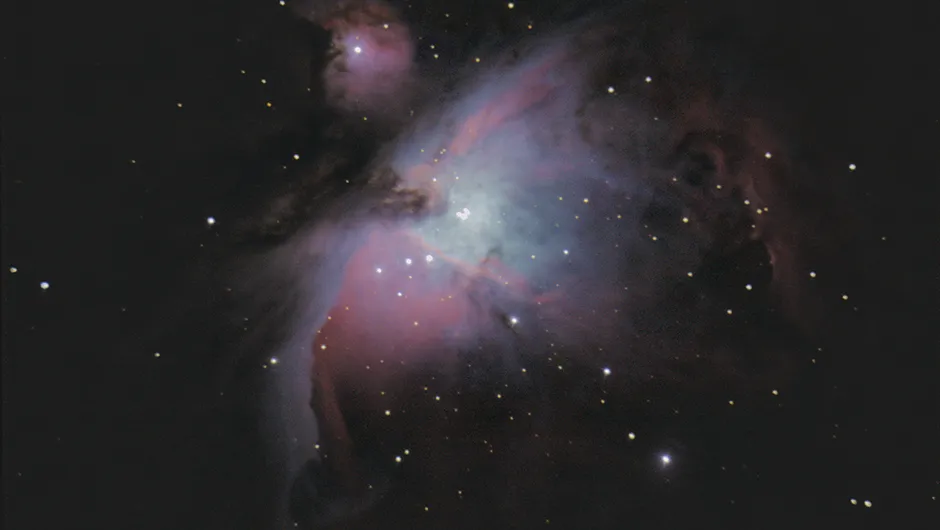Price: £5499.00
Aperture: 20-inch (508mm)
Focal Length: 2,000mm, f/4
Eyepieces: 10mm, 28mm,
Finderscope: 9x50 straight-through finderscope
Weight: 90kg
Supplier: Optical Vision Ltd
Website: www.opticalvision.co.uk
John Dobson dreamed of owning a large telescope that could give him views similar to those in photographs of the deep sky; little did he know that he’d start a revolution in telescope making.
Now Sky-Watcher has introduced its StarGate range of very large Dobsonian telescopes, consisting of the 450P (in two variants, basic and SynScan) and the 500P SynScan.
When we were offered the chance to review the latter, we couldn’t resist.
The StarGate 500P has a 508mm (20-inch) primary mirror with a focal length of 2,000mm to provide what’s known as a ‘fast’ focal ratio of f/4.
It comes with a 28mm, 2-inch (71x) and a 10mm, 1.25-inch (200x) eyepiece; a 9x50 straight-through finder; three 1kg counterweights; a light baffle and a fabric tube shroud.
A SynScan AZ hand controller and power cable complete the system.
This is a half-metre class instrument and weighs 90kg when fully assembled – make no mistake, it’s not for the faint hearted.
Initial assembly does include some fiddly small attachments, but once they’re in place they can be left alone.
You should also bear in mind that although we managed to assemble it on our own (just about) in around 30 minutes, the task is far easier with two people.
Power is provided by an optional 12V powertank and, once powered up, we used the handset to input details such as location, time and date.
We then had a choice of two alignment options: brightest star or two-star alignment.
Although each time the alignment was accurate, we did have an initial problem with the subsequent Go-Tos, which were often out by several degrees in azimuth.
With advice from Optical Vision, the suppliers, and Sky-Watcher, we were able to resolve the issue and subsequent Go-To sessions placed the targets in the inner 50 per cent of the view of the 28mm eyepiece.

Gasp-inducing views
We took a tour of some of the best deep-sky targets the sky has to offer and were wowed by the views.
In twilight, the double star Albireo was stunning in both eyepieces.
Later, under dark skies, the M35 star cluster in Gemini filled the view of the 28mm and we noted coloured stars scattered throughout it.<
We picked up the normally fainter nearby cluster NGC 2158, which was bright and a mass of stars.
Objects that appeared as a smudge of light in smaller instruments took on new life with the 500P, such as M1, the Crab Nebula, which showed as a strongly mottled oval with undulating edges and clear views of the central stars.
Turning to galaxies, we couldn’t help but gasp when we homed in on the Cigar Galaxy, M82, with the 10mm eyepiece and it displayed lots of the dust features we normally associate with photographs.
Dropping down to the 28mm eyepiece, we could just fit its neighbour M81 in the view with a clear spiral nature to it.
The Whirlpool Galaxy was replete with spiral structure and, as we continued our deep-sky tour, we could almost feel John Dobson beside us chuckling at our reaction to the views.
The Moon seemed like an odd target for such a ‘light bucket’, but was full of mesmerising detail.
We homed in on Uranus and were rewarded with a lovely pale green ball instead of the usual view of a small disc. We even picked out its five moons, although Miranda, being so close to the disc, was still a challenge.
Jupiter was spoiled by the low altitude and poor conditions in the early morning, yet the colours in its bands and the Great Red Spot were clearly visible.
Overall, the Stargate 500P is an impressive system; societies and clubs that have sufficient funds and want a real deep-sky light bucket with Go-To functionality will find that this is a great instrument to invest in.
Just remember to keep a step ladder with it, as looking up towards the zenith puts the eyepiece more than 2m above the ground!

Good at astrophotography too
For this review, we were kindly loaned an Ethos 21mm 100° eyepiece and a Parracor corrector by the Widescreen Centre.
We found the 21mm and StarGate 500P an ideal combination.
With it we examined a winter favourite, the Orion Nebula, and were bowled over with the amount of faint nebulosity and detail we could see – so much so that we coupled our Canon EOS 50D DSLR to see what we could capture.
This is an altaz system and does not follow the stars in an equatorial mode, so exposures must be short to avoid field rotation.
Even so, we captured many targets with just 10-second exposures, such as the Whirlpool Galaxy, M51, at ISO 2000, and the Orion Nebula at ISO 800.
Changing to our GPCAM2 290C, we captured the heart of the Orion Nebula and trapezium stars with 1/3-second exposures and stacked 200 frames to give a very satisfying result.
Overall, we had to conclude that this system is also a capable astrophotography instrument too.

Optics
The parabolic primary mirror has a diameter of 508mm (20-inch), which provides 61 per cent more light-gathering power than a 400mm (16-inch) mirror.
It has a focal length of 2,000mm, making it f/4 – a ‘fast’ system that gives bright views of the deep sky.
There’s a little coma around the edges of the field, which is typical of ‘fast’ systems.
SynScan AZ hand controller
Sky-Watcher’s SynScan AZ hand controller provides full control and setup for the Go-To and tracking with a database covering all the major catalogues, with 42,900+ objects.
It can be flash updated if required and the red-backlit, soft buttons are easy to use and see.
Mount base
The base is motorised and houses the motors and gears for both azimuth and altitude adjustments.
The clutches can be slightly loosened to allow for manual movement of the mount without losing Go-To alignment, a feature known as ‘Freedom-Find’.
Ports are included for the hand controller, auxiliary port adaptor, power connector and the cables providing connection to both axis motors and encoders.
Primary mirror assembly
This houses the 20-inch main mirror, the attachment blocks for the trusses and, at the rear, the counterweights and collimation system.
The latter we found a breeze to use. Once the finderscope and fabric shroud were added, an extra weight was required to achieve balance.
Truss and secondary assembly
The easy-to-assemble truss struts attach to the primary mirror assembly first, and then the secondary cage is attached.
The latter houses the Crayford-style, dual-speed focuser and the 9x50 finderscope.
The light baffle stops stray light entering the focuser assembly, while a fabric shroud (also included) can be used to protect and darken the tube.
This review originally appeared in the April 2018 issue of BBC Sky at Night Magazine